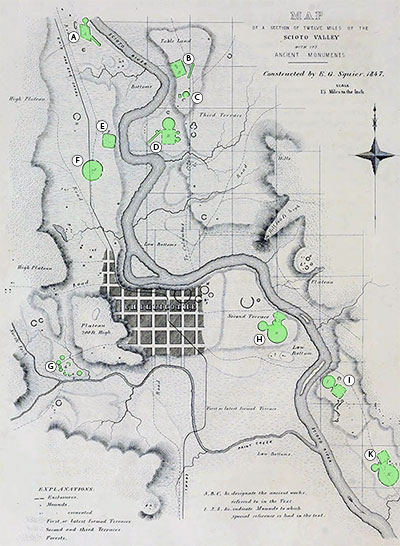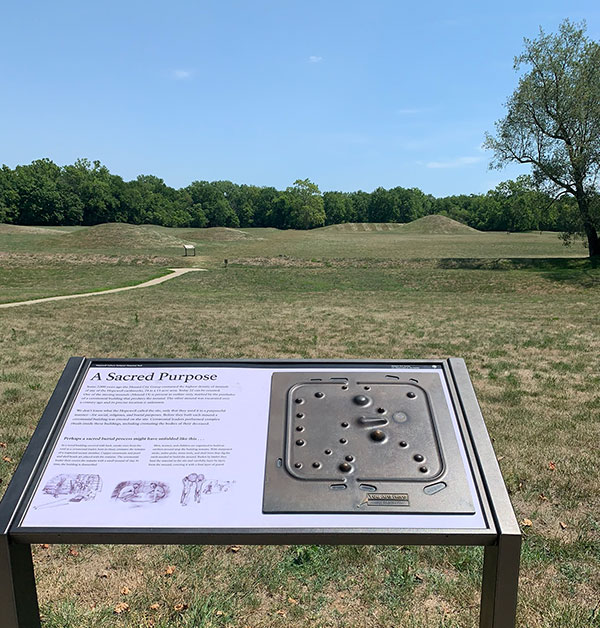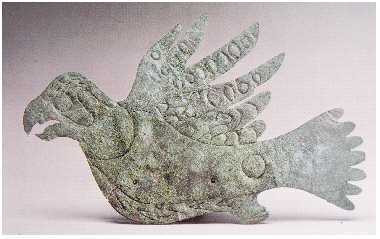Hopewell Culture National Historical Park Visitor Center and
Mound City Group - Chillicothe, Ohio

Inspired by map seen in " Hopewell Ceremonial Landscapes of Ohio"
Site: Hopewell Culture National Historical Park Visitor Center and Mound City Group
Location: 16062 OH-104, Chillicothe, OH 45601
Google Maps Link
Date of visit: July 2024
The third stop on my mini-mound tour was the Hopewell Culture Center and Mound City Group. The visitor's center opened my eyes to the number and variety of Hopewell mounds that once lined the banks of the Scioto River. The layout of the earthworks varied based on a theme using geometric shapes such as circles and rectangles. The video at the Visitor Center showed how the circles often fit into the squares and how the geometry of the sites is repeated.
Chillicothe was home to Edwin Davis, a local physician who was one of the authors of Ancient Monuments of the Mississippi Valley. Davis actively collected artifacts and had a lifelong interest in earthworks. By 1845, he corresponded with several prominent figures in anthropology. He met Ephraim Squier, his co-author in Chillicothe, and at first, they worked on “cabinets” or private artifact collections. In 1846, they headed east to raise money for a larger project. After a series of frustrating attempts to find backing, in 1847, they were contacted by Joseph Henry of the Smithsonian, and their book became the first volume published in the Contributions to Knowledge series by the Smithsonian. This account simplifies the hurdles that had to be met to publish their work and the disagreements between the authors. It helps explain why a sub-chapter of the book, "Altar or Sacrifcial Mounds," focuses on excavations they made in Mound City, which was 3 miles from Chillicothe.

Mound City
Of all the sites I visited in July, Mound City reminded me most of a graveyard, a walled place apart from everyday life with monuments honoring people who lived in the past. Surrounding the area is a 4-foot embankment with rounded corners and eight borrow pits lined with clay loam to hold water. The site has 23 to 24 mounds and is considered a unique mortuary and ceremonial enclosure. After Ancient Monuments of the Mississippi Valley was published, the landowner cut down the trees and began using the area for farming. In 1917, the Federal government purchased the land, and it became Fort Sherman, a U.S. Army training camp for WWI. Henry C. Sheltrone of the Ohio Archaeological and Historical Society convinced the camp commander to avoid building over the largest mound. Between 1920 and 1922, William C. Mills did further excavations of what was left of the site. Even though some mounds had been destroyed, they found many sub-mound artifacts. In 1923, the site was declared a National Monument. On August 1, 1946, the park was transferred to the stewardship of the National Park Service. The mounds we see now were rebuilt. During the 1963 excavation, research was done to find the exact location of the south wall.

Discoveries
Mound City was thought to been built between 100 BCE and CE 400. Each of the 24 mounds is unique in its construction and contents. They were all built in layers following the mound's profile. At the base were found what the Ancient Monuments of the Mississippi Valley called altars. Now called crematory basins, they were created from baked clay, each a different shape and containing ashes. Many items like breastplates, ear-ornaments, and pendants found had been broken, which William C. Mills calls a "killing" ceremony, intentionally destroying artifacts to deter looting. One mound was called "the Great Mica Grave," it had 6-inch sheets of mica around an oval ridge and more covering an area 7 foot long and 6 1/2 wide. Another mound had 200 broken carved effigy pipes. Multiple burials were found in some mounds; others had human bones and burnt bones. Some mounds were covered in pebbles and gravel that are now found dispersed throughout the site. Some of the more interesting artifacts from the site are copper double-headed eagles, a headdress shaped like a bear, and a mushroom wand thought to be of the Amanita variety, which might have been used in shamanic rituals. It is now believed that buildings to prepare the bodies after death were built before the mounds. Mounds later covered some of these buildings, while others were dismantled. The four-foot wall was built last.
Links to more information
- Mound City www.AncientOhioTrail.org
- Mound City Group The National Park Service Website
References
- Lynott, M. J. (2014) Hopewell Ceremonial Landscapes of Ohio
(Paperback Edition: 978-1-78297-754-4) Oxbow Books
Link to the book on Oxbow Books - Mills, W.C. (1920a) Exploration of the Mound City Group
Ohio Archeological and Historical Quarterly
Read the article online. - Squier, E.G and Davis, E.H. (1988) Ancient Monuments of the Mississippi Valley
(Paperback Edition: 978-1-56098-725-3) Smithsonian Books; 150th anniversary ed edition (October 17, 1998)
Available as a PDF at the U.S. Library of Congress Website